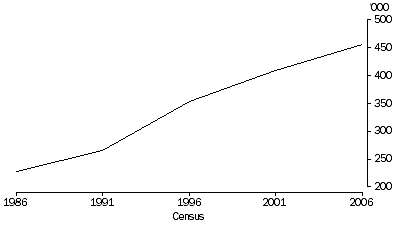INDIGENOUS POPULATION
Census Counts
The number of people identified as being of Aboriginal and/or Torres Strait Islander origin in the 2006 Census was 455,028 representing 2.3% of the total Australian population, as counted in the Census. This is an increase of 11% since the 2001 Census, compared with an increase of 3.8% in the non-Indigenous population over the same period. Over the past 20 years, the Census count of Indigenous people has doubled from 227,593 in 1986. Much of the growth in the Indigenous population can be explained by natural increase (births minus deaths). Other non-demographic factors, such as improvements in Census collection methods and people identified as being of Indigenous origin for the first time in the Census, also contribute to the growth.
Among people identified as Indigenous in 2006, 90% were of Aboriginal origin only, 6% were of Torres Strait Islander origin only and 4% were of both Aboriginal and Torres Strait Islander origin.
CENSUS INDIGENOUS POPULATION COUNTS

Of the states and territories, Victoria (20%), New South Wales (15%) and Queensland (13%) recorded the largest proportional increases in the Indigenous population Census counts.
Estimated Resident Population
The preliminary estimated resident Indigenous population of Australia was 517,174 or 2.5% of the total population, at 30 June 2006. This preliminary estimate is 14% higher than the 2006 unadjusted Census count (455,028) which reflects adjustments made on the basis of net undercount and unknown Indigenous status.
 Print Page
Print Page
 Print All
Print All
 Print Page
Print Page
 Print All
Print All